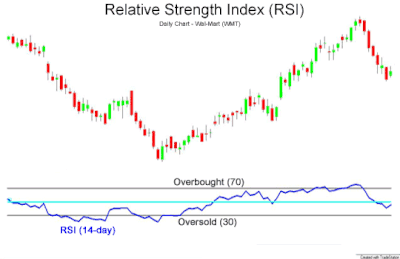Relative Strength Index Guide for Newbies
whether you want to trade stocks, forex, crypto currencies or anything in between one of the most important things that you need to know all about are indicators. In trading, indicators are very useful tools that provide you with many different types of information. Ultimately, indicators tell you exactly how, when and where to trade, so you can actually make money. Now, one of the best indicators out there that you could possibly use is the relative strength index, also known as the RSI. The relative strength index is one of the most popular and useful indicators out there at this time.
With all of that being said, although the relative strength index indicator is not overly hard indicator to use, a lot of people do get it wrong. What we want to do today is to take a much closer look at this RSI indicator to see exactly what it is and what it does for you. We also want to find out exactly what type of information it provides you with, as well as one of the biggest mistakes that people often make when using this relative strength index indicator. We’ve got some other useful tips for you as well, so stay tuned.
What is the Relative Strength Index Indicator?
The RSI indicator was first created by a man named J. Welles Wilder. Now, one of the most important things that you need to know about the relative strength index indicator is what type of indicator it is. The RSI is a momentum indicator, which means that it tells you the speed of a price movement or a trend. in other words, this is an indicator that can tell you how strong a trend is.
Moreover, the RSI indicator is often referred to as an oscillator, with the reason being that the values oscillate between 0 and 100. In case you have no idea what this means, if you are looking at an RSI indicator chart, the higher the RSI value is, the faster the prices going up, and vice versa. The lower the RSI Valuated, the faster the price is going down. Now one of the other most important things that you need to know here is what the formula is for calculating the relative strength index indicated.
100 – 100/[1 + RS]
Keep in mind that for this formula, RS stands for the average gain/average loss.

How the RSI Works
as you can tell from above, the formula for this relative strength index indicator is actually quite simple. One of the only confusing things about it is how to calculate the RS, which is of course the average gain divided by the average loss, but with a bit of practice, you should be able to master this no problem. the most important thing for you to know here is that when the RSI indicator goes up then the average gain is very large. The RSI indicator may also go up when the average loss is very small.
what is also extremely important for you to know is how the value of the average gains go up. This is actually quite simple. What you need to know here is that when the price of an asset or security moves upwards at a very quick rate and there are little or no pullbacks, than the average gains is going to be very large because the price is making positive gains and that will eventually lead to a higher RSI value.
On the other hand of the equation, if the price of an asset or a security falls very quickly combined with little or no pullbacks, then the average loss is going to be extremely large because the price is making negative gains and that will lead to a lower RSI value.
Yet another important thing that you need to know is that the value of the average gains and the average losses can be manipulated through altering the settings of the relative strength index indicator. To provide you with an example, you could use a five.
RSI, which then means that the average gain and the average loss will both be based on the last five candles. You could also do this for a 14 period RSI. align here is that the lower your relative strength index settings are, the more sensitive this indicator will be to the most recent price movements. If you use longer time periods, then the relative strength indicator will not be very sensitive to the most recent movements.
The Relative Strength Index Mistake
alright yet another thing that you need to know about this relative strength index indicator is the fact that when the value of it is above 70, then an asset is considered to be overbought and if the value of it is below 30 then an asset is considered to be oversold. Now, when RSI tells you that as security or an asset is oversold, many people might think that the market couldn’t possibly go any lower, so they hit the button to go and place a buy or long trade.
Now, this can actually be a mistake, because the RSI indicator measures the momentum of a market,. When RSI says that an asset is oversold, it generally signals that there is strong board bearish momentum in the market, and if it is overbought, then it signifies that there is strong bullish momentum. The mistake that many traders make is to blindly trade based on this RSI value.
What you need to know here is that you shouldn’t buy or sell a security just because the RSI said that it is either overbought or oversold. An asset or security can technically always be more oversold or overbought. This is not to say that the relative strength index indicator is not accurate, but you do need to be careful and generally speaking you do want to double check before placing a trade.
Winning Trades with the RSI
Just keep in mind that when the relative strength indicator index value is above 50, it generally means that the average gain is greater than the average loss. Now, in terms of using this particular indicator to win trades, how do you do this?
Well, the relative strength indicator makes for an awesome trend filter for something good to do is to turn your period to 200. This will allow you to identify the ratio of average gains to average losses over a very long period of time. If you see that the relative strength indicator index is over 50 for this 200 period, then you can assume that the market is trending upwards, and vice versa.
Bottom Line on the Relative Strength Index
As you can see, the relative strength index, or RSI indicator in one of the most useful ones out there, particularly when it comes to measuring the momentum or the strength of a trend. Although there is a lot more to learn about the relative strength index indicator we have provided you with a good base of knowledge that you can now build upon.
If you need help day trading, and what you need is a comprehensive education, particularly on Forex trading, then the best place to be is the Income Mentor Box Day Trading Academy. At this time, the IMB Academy is the most comprehensive, user friendly, effective, and affordable Forex trading school out there.





